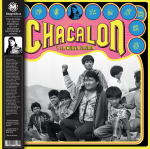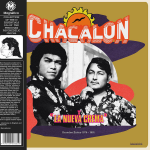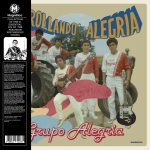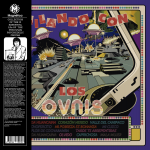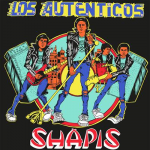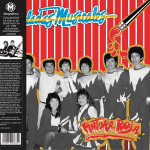Labels
Discos Horoscopo
- 01. Mi Dolor
02. Porque Te Amo
03. Llanto De Un Niño
04. María Teresa
05. Será Mejor
06. Por Ella, La Botella
07. Tú Y La Noche
08. Quiéreme
09. Mala Mujer
10. Nadie Conoce El Mundo
11. Sin Hogar
12. ChanaCHACALON Y LA NUEVA CREMA
Chacalon y la Nueva Crema
[engl] Lorenzo Palacios Quispe "Chacalón" is a myth. More than a musical star, he is both a religious and secular phenomenon for the masses. Every year on his birthday, his tomb becomes a place of fevered pilgrimage where devotees pray, make wishes and ask for miracles, all done over songs, cases of beer, dancing and toasting. In Peru, his figure and music erases the distance between the holy and the profane, the hero and the lumpen. Chacalón is, for many Peruvians, the people’s angel, the messiah of the poor, the marginalized ’Inkarri’. "When Chacalón sings, the hills come down", was one of his favorite phrases and with it he referred to the migrant masses that invaded the hills and beaches that surround Lima like a "ring of fire" (José María Arguedas dixit). It was the early 80s and while bombs and a dirty war exploded in the Andes, in Lima, the new and ever–growing population of migrants "climbed down" from their precarious homes and filled venues to dance "chicha" music and to celebrate who they saw as their redeemer. Despite being a model messianic figure, Lorenzo Palacios had very humble origins. The son of a music dancer from Huancayo and a singer of huayno music (Andean folk) from Ayacucho, Chacalon was born in Lima in 1950. As a teen, he had his debut on stage as the singer of huayno band "The Indios Quechuas". The main requirement to sing that genre of music was to have a powerful ribcage and young Lorenzo seemed to have the needed lung capacity for "guapeos", thunderous voice blows that the genre required. Chicha music is neither a replica or a copy, despite using Western instruments, such as the electric guitar, bass, drums and organs, and mixing them with cymbals, congas and tropical Guiros. Chicha music has indomestizo elements (like Huayno music) tucked deep in his blood. Listen to the powerful cries of Chacalon and you will hear the heartfelt music of Huancayo; listen to his delicate voice breaks and you will hear the sweet music of Ayacucho. The mix of delicacy and strength and rural and cosmopolitan elements, is part of the secret of seduction that chicha music has had over the masses. Aside from use of electric instruments, rock music has influenced chicha music in other ways. Chacalón’s band was called New Cream as a tribute to the British band Cream. Their use of powerful fuzz tones and wah wah pedals for acid riffs and catchy solos, are the echoes of a rebellious music that wanted to silence the noises of a marginalized and exploitative city atmosphere debased by the most savage capitalism. "I seek a new life in this city / where everything is money and there is evil, " reads "Provinciano", Chacalon’s most famous songs. It’s because lyrics like these that people saw Chacalón as a messianic figure who sang about the promise of a new life. He sang about pain, alcohol and betrayal, but also about solidarity, love and hope. Chacalon sang to the most marginalized part of society, the lumpenproletariat, and not the middle class or the wealthy. Lorenzo Palacios did not see differences between those who complied with the law or those who transgressed it, because in marginality, survival is the only rule and the boundaries between good and evil become very subtle. "Eat first, then morals, " said Chacalon.- Format
- DoLP
- Release-Datum
- 22.03.2019
- EAN
- EAN 4040824087111
- 01. Ven Mi Amor
02. Lágrima De Amor
03. Amor, Por Qué?
04. Sufrir Llorar, Para Qué?
05. Amor Ideal
06. Soy Provinciano
07. Poco A Poco
08. Porque La Quiero
09. Dame Tu Amor
10. Ese Amargo Amor
11. Señor Ten Piedad De Mí
12. La Paz Y La DichaCHACALON Y LA NUEVA CREMA
Grandes Éxitos 1976-1981
[engl] This compilation originally appeared in 1982 under the title of “Éxitos, éxitos, éxitos”. It gathered some of the first recordings by Chacalón y La Nueva Crema that were released on 7-inch records between 1977 and 1981. These twelve themes were written during the years of the de facto government of Francisco Morales Bermúdez. This dictatorship led Peru to an institutional and economic crisis that also affected major record labels, which opted to publish foreign musicians to insure sales. Although Chacalon’s career experienced highs and lows after the release of this album, his intimate relationship with his audience remained, carried to levels as extreme as the ones he told Caretas magazine in July 1983: "Once we were playing at a venue on Mexico Avenue, I was singing a song called “Llanto de un niño”, about a boy who was born in poverty, he has to leave his small town with his family. On the coast his father becomes a fisherman and dies, the son wants to send a letter to heaven. While I was singing, a guy who was there, at the front, pulled a switchblade and cut open his veins. He saved himself and then told me later that he had suffered a lot like the child in the song. Yes, the man had been drinking.”- Format
- DoLP
- Release-Datum
- 22.03.2019
- EAN
- EAN 964943392435
- 01. Conmuevéte
02. Refugio En El Licor
03. Vete Y No Vuelvas
04. Por Culpa De Una Riña
05. Tu Cambiaste Mi Vida
06. El Puñal De Tu Traición
07. Es Un Pecado
08. El Solitario
09. Pequeño Luchador
10. Mendigo De Amor
11. Dios Mio Cuida Mi Hogar
12. Nuestro Amor Ya No VolveráGRUPO ALEGRIA
Arrollando Con Alegria
- Format
- DoLP
- Release-Datum
- 04.11.2019
- 01. Mala Mujer
02. Chofercito
03. Caprichosa
04. Linda Huancaína
05. Flor De Cochabamba
06. Olvido
07. Linda Colegiala
08. Corazón Herido
09. Tarde Te Arrepentirás
10. Mi Pobreza Es Bonanza
11. Mi Cuzco
12. Valle Del CanipacoLOS OVNIS
Bailando Con Los Ovnis
- Format
- DoLP
- Release-Datum
- 04.11.2019
- 01. El Aguajal
02. Tu Boda
03. Esperanza De Amor
04. Volveras Mi Niño
05. Mal Amigo
06. En La Selva
07. Borrachito Borrachon
08. Mi Tallercito
09. Angelita
10. Como Un Errante
11. Si No Regresa
12. PerdidosLOS SHAPIS
Los Auténticos Shapis
[engl] Los Shapis, a legendary group of tropical Peruvian music, will be relaunching their first LP ’Los auténticos’ (1981) on the 23rd of December. The revival of this album, which was one of the pioneers of Andean Cumbia, will commemorate the 36th anniversary of the band led by Julio Simeón ("Chapulín el Dulce") and Jaime Moreyra and will include emblematic songs such as ’El Aguajal’ and ’Como un errante’. The relaunching of ’Los auténticos’ forms part of a project to rescue and revive Discos Horóscopo, a record label founded 40 years ago by Juan Campos Muñoz, and which boasts one of the most important catalogues of chicha music from the 70s and 80s. The label was created and can be recognized as the main driving force of Andean cumbia in Lima, as it took on producing albums of artists that gambled on not only creating a new sound, but also molding a new type of aesthetic, led by Chacalón y La Nueva Crema, Los Shapis, Pintura Roja and Los Ovnis. Formed in the city of Huancayo on February 14, 1981, Los Shapis – whose name was inspired by a traditional dance, "Los Shapis de Chupaca" – were hailed as ambassadors of chicha when they toured throughout different countries, which gave birth to the internationalization of Peruvian cumbia in the early 1980s By 1983, the band was based out of Lima. Its members composed iconic songs about the provincial and profound identity of Peru, in a time marked by racism and classism from the most privileged sectors. A rhythmic tradition that would accompany the two most conflictive phenomena of the era: terrorism and economic debacle, reasons that motivated the massive migration from the countryside to the city. "It is a culture that alludes to disorder and popular excess, drunkenness and chaos, but also a way of appropriating while simultaneously mocking the west, " says researcher Alfredo Villar, collaborator of the project to revalorize Peruvian cumbia.- Format
- DoLP
- Release-Datum
- 22.03.2019
- 01. Pintura Roja - El Teléfono
02. Sola
03. Petiso
04. Te Olvidaste
05. Recuerdos
06. Oh Virgen María
07. Padre Olvidado
08. El Chinito Nº 2
09. Ayúdame Tu.
10. Pintura Roja - Pinceladas MusicalesPINTURA ROJA
Pinceladas Musicales
[engl] The nickname is superb, as unappealable: The University of Chicha. It is not an exaggeration that, 32 years after the release of Pinceladas Musicales, their second LP, the cumbia band Pintura Roja continues to be recognized as a monumental institution in the history of Peruvian music. Since its foundation in 1984, Pintura Roja has served as the quarry of the greatest exponents of "chicha" music, cultivating in the classrooms of its academy artists like Princesita Mily, considered one of the first women to integrate a chicha band, and Muñequita Sally, the disappeared queen of Andean folk, in addition to the legendary vocalist Toño Centella and the remembered Jhonny Orosco, founder of Grupo Néctar. Pintura Roja is revolution, innovation, success. It is a commitment to originality, as well as a history of defections and tragedies. But above all, Pintura Roja is Alejandro Zárate Espinoza, its founder, director, composer and lead guitarist. He’s "The Gentleman of Cumbia". In 1984, Pintura Roja is called by Discos Horóscopo to record an LP before the end of the year. The group begins to capture the attention of the public, otherwise, curious about the voice of a woman that they initially confuse with the voice of a child, or perhaps attracted to their lyrics that reflected the dramas and common situations experienced daily by migrants and their first generations in Perú’s capital: the abandonment of parents and sentimental counterparts, the incipient poverty and the uncertain present in which they lived. The woman as a fighter, capable of facing alone adversity and triumphant over sexism, appears in some songs, giving it greater relevance the fact that a woman with the power that her voice gave her, sang to them from the top of the stage. In 1985, Pintura Roja gained popularity on the radio and acquired a one-hour program on Radio Inca called "Pinceladas Musicales". That year, readers of the newspaper El Popular choose it as the favorite band of the year. It is for the second production that Zárate decided to seek support for Mily, who at that time danced and sang for up to six hours in each presentation. Zárate signs Sara Barreto, a 14-year-old huayno singer known as "Natachita", and gives her a new artistic name: La Muñequita Sally.- Format
- DoLP
- Release-Datum
- 22.03.2019
- EAN
- EAN 8517441224497

